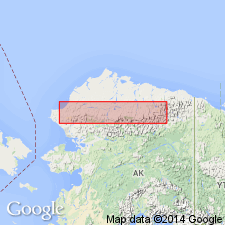
- Usage in publication:
-
- Otuk Formation*
- Modifications:
-
- Named
- Biostratigraphic dating
- Dominant lithology:
-
- Shale
- Chert
- Limestone
- AAPG geologic province:
-
- Alaska Northern region
Summary:
Named for Otuk Creek, tributary of East Fork of Etivluk River in western Killik River (1:250,000) quad as upper formation (of 2) of Etivluk Group (new). Type section is located on bluff on east bank of Otuk Creek, sec.31 T10S R16W, Killik River quad, northern AK. Rocks previously assigned to Shublik Formation in most of Endicott and DeLong Mountains by Chapman and others (1964). Otuk is characterized by distinctive rock types not present within Shublik in its type area in Shublik Mountains. Shublik is confined to autochthonous terrane whereas Otuk, as presently recognized, is confined to allochthonous sheets of central and western Brooks Range and in Porcupine Lake area of Philip Smith Mountains. Reference sections designated at Agate Rock, tributary of Kelly River, Monotis Creek, and Tiglukpuk Creek. Divided into (ascending): shale member, chert member, limestone member, and Blankenship Member (new). Overlies Siksikpuk Formation (Etivluk Group). Disconformably underlies rocks of Jurassic or Cretaceous age. Distinctive ammonoid and pectenacid bivalve faunas and conodonts indicate Otuk Formation ranges in age from late Early Triassic to early Middle Jurassic.
Source: GNU records (USGS DDS-6; Menlo GNULEX).
For more information, please contact Nancy Stamm, Geologic Names Committee Secretary.
Asterisk (*) indicates published by U.S. Geological Survey authors.
"No current usage" (†) implies that a name has been abandoned or has fallen into disuse. Former usage and, if known, replacement name given in parentheses ( ).
Slash (/) indicates name conflicts with nomenclatural guidelines (CSN, 1933; ACSN, 1961, 1970; NACSN, 1983, 2005, 2021). May be explained within brackets ([ ]).

